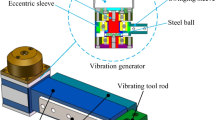Abstract
Using a diamond cutting tool in the precision turning process, the vibration of tool-tip has an undesirable effect on the machined surface’s quality. The objective of this paper is to analyze the design of turning tool-bar combined with the rubber-layered laminates for minimizing the vibration amplitude of tool-tip in the precision turning with the diamond tool. The selected rubber materials are styrene butadiene rubber (SBR) and silicone rubber (SI). Machining parameters, including the spindle speed, feed rate, and cutting depth, were chosen as numerical factors, and the status of the rubber-layered laminates was regarded as the categorical factor. The status of the rubber-layered laminates set up three categories including the solid tool (without rubber-layered laminates), tool with SBR rubber-layered laminate, and tool with SI rubber-layered laminate. An experimental plan of a four-factor (three numerical plus one categorical) D-optimal design based on the response surface methodology was employed to carry out the experimental study. The results show that the design of the turning tool-bar combined with the rubber-layered laminates is proven to improve the damping forces of the turning tool-bar. The overall vibration on the tool-tip using the tool with the rubber-layered laminates tends to be in a more stable condition, which leads to the result of having the best machined surface. With experimental values up to a 95% confidence interval, it is fairly well for the experimental results to present the mathematical models of the surface roughness without/with the rubber-layered laminates.
Similar content being viewed by others
References
Shimada S, Tanaka H, Higuchi M, Yamaguchi T, Honda S, Obata K (2004) Thermo-chemical wear mechanism of diamond tool in machining of ferrous metals. Ann CIRP 53(1):57–60
Sreejith PS, Krishnamurthy R, Malhota SK, Narayanasamy K (2000) Evaluation of PCD tool performance during machining of carbon/phenolic ablative composites. J Mater Process Technol 104:53–55
Davim JP, Mata F (2005) Optimisation of surface roughness on turning fibre-reinforced plastics (FRPs) with diamond cutting tools. Int J Adv Manuf Technol 26:319–323
Cowley A (1970) Structural analysis. Machine tool structures. Pergamon, Oxford
Marinescu I, Ispas C, Boboc D (2002) Handbook of machine tool analysis. Marcel Dekker, New York
Dimla DE Sr (2004) The impact of cutting conditions on cutting forces and vibration signals in turning with plane face geometry inserts. J Mater Process Technol 155–156:1708–1715
Rashid A, Nicolescu CM (2006) Active vibration control in palletised work holding system for milling. Int J Mach Tools Manuf 46(12–13):1626–1636
Bispink T (1992) Performance analysis of feed-drive systems in diamond-turning by machining specified test samples. Ann CIRP 41:601–604
Takasu S, Masuda M, Nishiguchi T (1985) Influence of study vibration with small amplitude upon surface roughness in diamond machining. Ann CIRP 34:463–467
Cheung CF, Lee WB (2000) A theoretical and experimental investigation of surface roughness formation in ultra-precision diamond turning. Int J Mach Tools Manuf 40:979–1002
Lin SC, Hu MR (1992) Low vibration control system in turning. Int J Mach Tools Manuf 32:629–640
Choudhury SK, Sharath MS (1995) On-line control of machine tool vibration during turning. J Mater Process Technol 47:251–259
Tewani SG, Rouch KE, Walcott BL (1995) A study of cutting process stability of a boring bar with active dynamic absorber. Int J Mach Tools Manuf 35:91–108
Choudhury SK, Mathew J (1995) Investigations of the effect of non-uniform insert pitch on vibration during face milling. Int J Mach Tools Manuf 35(10):1435–1444
Zhang JZ, Chen JC (2008) Tool condition monitoring in an end-milling operation based on the vibration signal collected through a microcontroller-based data acquisition system. Int J Adv Manuf Technol 39:118–128
Golyandina N, Nekrutkin V, Zhigljavsky A (2001) Analysis of time series structure—SSA and related techniques. Chapman & Hall, Boca Raton, FL, pp 13–78
Myers RH, Montgomery DC (1995) Response surface methodology: process and product optimization using designed experiments. Wiley, New York
Khuri AI, Cornell JA (1996) Response surfaces, designs and analyses. Marcel Dekker, New York
Puri AB, Bhattacharyya B (2005) Modeling and analysis of white layer depth in a wire-cut EDM process through response surface methodology. Int J Adv Manuf Technol 25:301–307
Lin BT, Jean MD, Chou JH (2007) Using response surface methodology with response transformation in optimizing plasma spraying coatings. Int J Adv Manuf Technol 34:307–315
Davim JP, Gaitonde VN, Karnik SR (2008) An investigative study of delamination in drilling of medium density fibreboard (MDF) using response surface models. Int J Adv Manuf Technol 37:49–57
Palanikumar K (2008) Application of Taguchi and response surface methodologies for surface roughness in machining glass fiber reinforced plastics by PCD tooling. Int J Adv Manuf Technol 36:19–27
Çaydaş U, Hasçalik A (2008) Modeling and analysis of electrode wear and white layer thickness in die-sinking EDM process through response surface methodology. Int J Adv Manuf Technol 38:1148–1156
Munda J, Bhattacharyya B (2008) Investigation into electrochemical micromachining (EMM) through response surface methodology based approach. Int J Adv Manuf Technol 35:821–832
Author information
Authors and Affiliations
Corresponding author
Rights and permissions
About this article
Cite this article
Chen, CC., Chiang, KT. Analyzing the design of vibration reduction with the rubber-layered laminates in the precision turning with a diamond cutting tool. Int J Adv Manuf Technol 57, 101–116 (2011). https://doi.org/10.1007/s00170-011-3281-y
Received:
Accepted:
Published:
Issue Date:
DOI: https://doi.org/10.1007/s00170-011-3281-y




